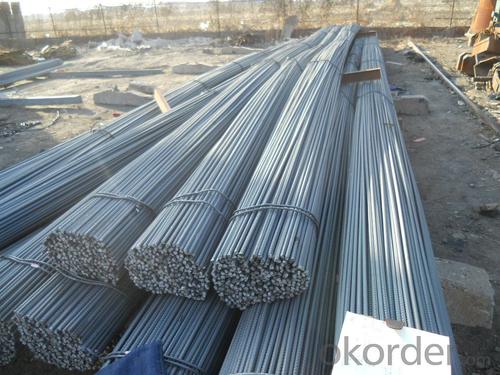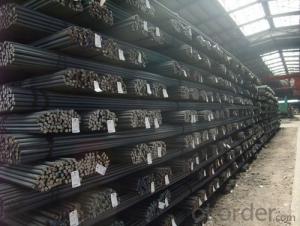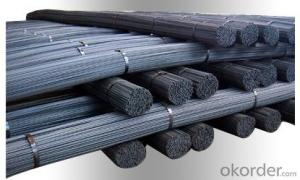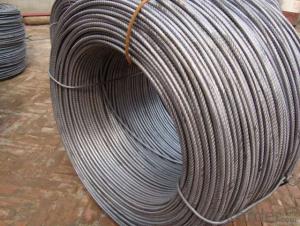HRB400 Deformed Steel Bar with high quality
- Loading Port:
- China Main Port
- Payment Terms:
- TT or LC
- Min Order Qty:
- -
- Supply Capability:
- -
OKorder Service Pledge
OKorder Financial Service
You Might Also Like
Product Description:
OKorder is offering HRB400 Deformed Steel Bar with high quality at great prices with worldwide shipping. Our supplier is a world-class manufacturer of steel, with our products utilized the world over. OKorder annually supplies products to European, North American and Asian markets. We provide quotations within 24 hours of receiving an inquiry and guarantee competitive prices.
Standard | GB | HRB400 | |
Diameter | 6mm,8mm,10mm,12mm,14mm,16mm,18mm,20mm, 22mm,25mm,28mm,32mm,36mm,40mm,50mm | ||
Length | 6M, 9M,12M or as required | ||
Place of origin | Hebei, China mainland | ||
Advantages | exact size, regular package, chemical and mechanical properties are stable. | ||
Type | Hot rolled deformed steel bar | ||
Brand name | CNBM | ||
Theoretical weight and section area of each diameter as below for your information:
Diameter(mm) | Section area (mm²) | Mass(kg/m) | Weight of 12m bar(kg) |
6 | 28.27 | 0.222 | 2.664 |
8 | 50.27 | 0.395 | 4.74 |
10 | 78.54 | 0.617 | 7.404 |
12 | 113.1 | 0.888 | 10.656 |
14 | 153.9 | 1.21 | 14.52 |
16 | 201.1 | 1.58 | 18.96 |
18 | 254.5 | 2.00 | 24 |
20 | 314.2 | 2.47 | 29.64 |
22 | 380.1 | 2.98 | 35.76 |
25 | 490.9 | 3.85 | 46.2 |
28 | 615.8 | 4.83 | 57.96 |
32 | 804.2 | 6.31 | 75.72 |
36 | 1018 | 7.99 | 98.88 |
40 | 1257 | 9.87 | 118.44 |
50 | 1964 | 15.42 | 185.04 |
Note:
1. Our products are produced according to national standard (GB), if not, supply according to national standards (GB) or agreement as customer required.
2. Other Grade and Standard Deformed Steel Bar we can supply:
Grade: GR40/GR60, G460B/B500A/B500B/B500C,BST500S
Standard: ASTM, BS, DIN
The Minimum Order Quantity of these products is high, and need to be confirmed.
3. We can not only supply Deformed Steel Bar; if you need anything about building materials, please contact us for further information.
4. Please send us your detail specifications when inquire. We will reply to you as soon as possible. We sincerely hope we can establish a long stable business relationship.
Product Applications:
HRB400 Deformed Steel Bar with high quality are ideal for structural applications and are widely used in the construction of buildings and bridges, and the manufacturing, petrochemical, and transportation industries.
Product Advantages:
OKorder's HRB400 Deformed Steel Bar with high quality are durable, strong, and resist corrosion.
Main Product Features:
· Premium quality
· Prompt delivery & seaworthy packing (30 days after receiving deposit)
· Corrosion resistance
· Can be recycled and reused
· Mill test certification
Product Specifications:
Standard: GB
Material: Q235
Origin place: China
Thickness: 3mm-30mm
Width:20mm-200mm
Length: Max 12m
FAQ:
Q1: What makes stainless steel stainless?
A1: Stainless steel must contain at least 10.5 % chromium. It is this element that reacts with the oxygen in the air to form a complex chrome-oxide surface layer that is invisible but strong enough to prevent further oxygen from "staining" (rusting) the surface. Higher levels of chromium and the addition of other alloying elements such as nickel and molybdenum enhance this surface layer and improve the corrosion resistance of the stainless material.
Q2: How do we guarantee the quality of our products?
A2: We have established an advanced quality management system which conducts strict quality tests at every step, from raw materials to the final product. At the same time, we provide extensive follow-up service assurances as required.
Q3: How soon can we receive the product after purchase?
A3: Within three days of placing an order, we will begin production. The specific shipping date is dependent upon international and government factors, but is typically 7 to 10 workdays.
bdenum enhance this surface layer and improve the corrosion resistance of the stainless material.
Images:
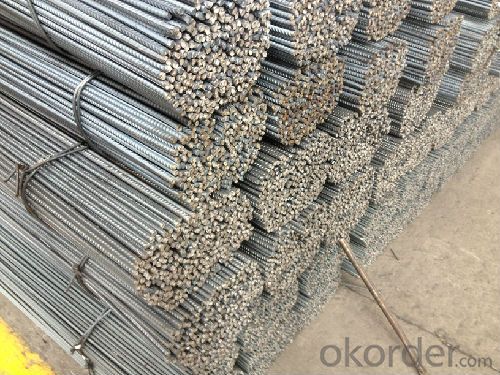
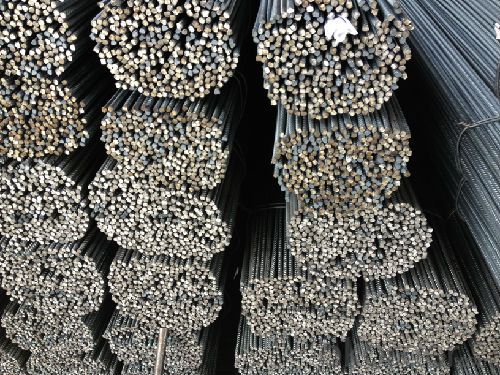
- Q: How do steel rebars affect the structural capacity of concrete beams and columns?
- The role of steel rebars in enhancing the structural capacity of concrete beams and columns cannot be overstated. These rebars serve as reinforcement, providing added strength and durability to the concrete elements. When steel rebars are incorporated into the concrete, the load-bearing capacity of the beams and columns is significantly increased. One of the main functions of steel rebars is to counteract the tensile forces that concrete alone cannot withstand. Concrete is strong under compression but weak under tension, which makes it prone to cracking and failure when subjected to tensile stress. By integrating steel rebars into the concrete, the tensile strength of the reinforced element is greatly improved. The steel rebars act as a framework within the concrete, distributing the load more evenly and reducing the risk of localized failure. When external loads or forces are applied, the rebars bear the tensile stress while the concrete maintains its compressive strength. This combination of materials creates a reinforced concrete element that can handle heavier loads, thus increasing the structural capacity of the beams and columns. Moreover, steel rebars also enhance the ductility and flexibility of the concrete elements. This means that the reinforced beams and columns can undergo greater deformations before reaching failure. The ability to deform without breaking is particularly important in regions prone to earthquakes, as it allows the structure to absorb and dissipate energy, thereby minimizing the risk of collapse. Additionally, steel rebars improve the resistance of concrete beams and columns against shrinkage and thermal stresses. Concrete tends to shrink as it cures and expand and contract due to temperature variations. The presence of steel rebars helps minimize these effects by providing a reinforcing network that restrains the concrete from excessive movements, preventing cracks and preserving the overall structural integrity. In conclusion, steel rebars have a profound impact on the structural capacity of concrete beams and columns. They enhance tensile strength, improve ductility, reduce shrinkage and thermal stresses, and increase overall load-bearing capacity. The combination of concrete and steel reinforcement produces a significantly stronger and more durable structural element that can withstand higher loads, ensuring the stability and safety of the entire structure.
- Q: What are the maintenance requirements for steel rebars in a structure?
- The maintenance requirements for steel rebars in a structure typically involve regular inspections, cleaning, and protection against corrosion. Inspections should be conducted to identify any signs of rust, cracks, or other damage that could compromise the strength of the rebars. Cleaning is essential to remove any dirt, debris, or chemicals that may accumulate on the rebars and accelerate corrosion. Applying protective coatings or coatings that inhibit corrosion can help extend the lifespan of the rebars. Additionally, ensuring proper drainage and preventing moisture buildup in the structure can also contribute to the maintenance of steel rebars.
- Q: What are the benefits of using stainless steel rebars?
- There are several benefits of using stainless steel rebars in construction projects. Firstly, stainless steel rebars offer excellent corrosion resistance. This is particularly important in environments with high humidity, coastal areas, or projects where the concrete will be exposed to water or chemicals. Unlike traditional carbon steel rebars, stainless steel rebars do not rust or corrode easily, ensuring the long-term integrity and durability of the structure. Secondly, stainless steel rebars have a higher tensile strength compared to carbon steel rebars. This means that they can withstand greater forces and stresses without deforming or breaking. This makes stainless steel rebars ideal for structures that require high load-bearing capacity, such as bridges, parking garages, and high-rise buildings. Furthermore, stainless steel rebars have a low thermal expansion coefficient. This means that they do not expand or contract significantly with changes in temperature. This property helps to minimize cracking and structural damage due to thermal stresses, ensuring the longevity and stability of the concrete structure. In addition to their mechanical properties, stainless steel rebars are also aesthetically pleasing. With their sleek and shiny appearance, stainless steel rebars can enhance the visual appeal of architectural elements such as exposed concrete walls or features in bridges and buildings. Lastly, stainless steel rebars are environmentally friendly. They are 100% recyclable, making them a sustainable choice for construction projects. By using stainless steel rebars, builders and engineers can contribute to reducing the carbon footprint and promoting a greener construction industry. Overall, the benefits of using stainless steel rebars include superior corrosion resistance, high tensile strength, low thermal expansion, aesthetic appeal, and environmental sustainability. These advantages make stainless steel rebars a preferred choice for various construction applications, providing long-lasting and reliable reinforcement for concrete structures.
- Q: What are the methods used for corrosion protection of steel rebars?
- There are several methods used for corrosion protection of steel rebars. 1. Coating: One common method is to apply a protective coating on the surface of the steel rebar. This coating acts as a barrier, preventing moisture and oxygen from reaching the steel surface and causing corrosion. Coatings can be applied using various techniques such as hot-dip galvanizing, epoxy coatings, or fusion-bonded epoxy coatings. 2. Cathodic Protection: Another method is cathodic protection, which involves the use of sacrificial anodes or impressed current systems. Sacrificial anodes are made of a more reactive metal (such as zinc or magnesium) that corrodes over time instead of the steel rebar. This ensures that the steel remains protected. Impressed current systems use an external power source to provide a protective current to the steel rebar, preventing corrosion. 3. Concrete cover: A simple but effective method is to provide a sufficient concrete cover over the steel rebar. The concrete acts as a physical barrier, shielding the steel from the environment. The thickness of the concrete cover is critical and should be designed according to specific standards to ensure adequate protection. 4. Inhibitors: Corrosion inhibitors can be added to the concrete mix or applied on the surface of the steel rebar. These inhibitors work by reducing the corrosive effects of moisture and oxygen on the steel surface. They can be organic or inorganic compounds that form a protective layer on the steel, inhibiting the corrosion process. 5. Proper design and construction practices: Lastly, proper design and construction practices can greatly contribute to corrosion protection. This includes avoiding the use of dissimilar metals that can cause galvanic corrosion, ensuring proper drainage to prevent water accumulation, and taking measures to minimize exposure to corrosive environments. It is important to note that a combination of these methods is often used to provide optimal corrosion protection for steel rebars, depending on the specific project requirements and environmental conditions.
- Q: How do steel rebars affect the overall acoustic properties of a structure?
- The overall acoustic properties of a structure are greatly affected by steel rebars, also known as reinforcement bars. Steel rebars can have both positive and negative effects on the acoustic characteristics of a building or infrastructure. One way in which steel rebars impact the acoustic properties is through their ability to transmit sound vibrations. Steel, being a good conductor of sound, easily allows sound waves to travel. Consequently, when steel rebars are present in a structure, they act as pathways for sound transmission, allowing it to easily travel throughout the building. This can result in increased noise levels and reduced acoustic privacy, as sound waves can travel through the steel rebars and reach different areas of the structure. However, steel rebars can also contribute to the overall sound insulation of a structure. When properly installed and integrated with other construction materials like concrete or acoustic insulation materials, steel rebars help reduce the transmission of sound waves. The stiffness and mass of steel rebars help dampen the vibrations caused by sound waves, thereby reducing the amount of sound that passes through the structure. This enhances the acoustic comfort within the building, creating a quieter environment suitable for various activities that require reduced noise levels. It is important to note that the impact of steel rebars on the acoustic properties of a structure depends on various factors, including the thickness and density of the surrounding construction materials, the arrangement and spacing of the rebars, and the overall design of the building. Additionally, the use of additional acoustic treatments like sound-absorbing panels or insulation can further improve the acoustic performance of a structure by mitigating the negative effects of steel rebars. In conclusion, steel rebars play a significant role in the overall acoustic properties of a structure. While they can facilitate the transmission of sound waves, they can also contribute to sound insulation when combined with appropriate construction materials and techniques. Proper design and implementation, along with the use of additional acoustic treatments, are crucial in achieving the desired acoustic environment in buildings and infrastructure where steel rebars are present.
- Q: What are the benefits of using stainless steel rebars?
- Some benefits of using stainless steel rebars include their high corrosion resistance, durability, and strength. Stainless steel rebars do not rust or corrode like traditional steel rebars, making them ideal for construction projects in areas with high humidity or exposure to corrosive elements. They also have a longer lifespan, reducing the need for frequent replacements and maintenance. Additionally, stainless steel rebars offer better structural integrity and can withstand higher loads, ensuring the longevity and safety of the structures they reinforce.
- Q: How are steel rebars used in the construction of chemical processing plants?
- Steel rebars are commonly used in the construction of chemical processing plants to provide structural reinforcement and increase the overall strength and durability of the structures. These rebars, also known as reinforcing bars, are typically made of carbon steel and are used to reinforce concrete structures such as foundations, walls, columns, and beams. Chemical processing plants often involve the handling of hazardous and corrosive substances, which can put significant stress on the infrastructure. Steel rebars are crucial in ensuring the integrity of the structures and preventing potential collapse or failure. In the construction of chemical processing plants, steel rebars are usually embedded within the concrete to form a reinforced concrete structure. This combination of concrete and steel rebars creates a composite material that has enhanced tensile strength, allowing it to withstand the heavy loads, vibrations, and extreme temperature fluctuations commonly found in chemical plants. Additionally, the use of steel rebars helps prevent cracks and structural deformations caused by shrinkage, settling, or external forces. This is important in chemical processing plants where maintaining a secure and stable environment is crucial for the safety of employees and the integrity of the plant's operations. Moreover, steel rebars offer excellent resistance to corrosion, which is vital in chemical processing plants where exposure to corrosive chemicals and high humidity levels is common. By providing a protective barrier to the underlying concrete, steel rebars help prevent corrosion-induced deterioration, extending the lifespan of the structures and reducing maintenance costs. Overall, steel rebars play a critical role in the construction of chemical processing plants by ensuring the structural stability, durability, and resistance to corrosion necessary for the safe and efficient operation of these facilities.
- Q: Can steel rebars be used in decorative or artistic applications?
- Yes, steel rebars can be used in decorative or artistic applications. They can be shaped, welded, and bent to create unique and visually appealing designs. Steel rebars can be used in sculptures, furniture, architectural features, and other artistic projects, adding a modern and industrial touch to the overall aesthetic.
- Q: How do steel rebars affect the overall construction cost of residential buildings?
- The overall construction cost of residential buildings can be significantly influenced by steel rebars. To begin with, steel rebars play a vital role in reinforced concrete structures by adding strength and durability. However, the cost of steel rebars can vary depending on factors such as size, grade, and the quantity required for the project. The inclusion of steel rebars in residential buildings can lead to increased construction costs due to expenses related to their purchase and installation. The cost of steel itself is subject to market fluctuations and can change over time. Furthermore, the complexity of the design and the amount of reinforcement needed can also impact the overall cost. Moreover, the installation of steel rebars involves skilled labor, which further contributes to construction expenses. The process of cutting, bending, and placing rebars requires expertise and precision, which adds to the cost of labor. Additionally, the time required for proper installation can affect the construction schedule, potentially resulting in additional expenses if there are delays. However, it is important to note that although steel rebars may initially increase the upfront construction cost of residential buildings, their long-term benefits outweigh the initial expenses. Reinforced concrete structures with steel rebars offer improved resistance against structural failures, such as cracking or collapsing, which can save significant costs in terms of future repairs and maintenance. In conclusion, steel rebars are essential components in residential construction as they enhance the strength and durability of reinforced concrete structures. While their use may increase the initial construction cost, the long-term advantages in terms of structural integrity and reduced maintenance expenses justify their inclusion in residential building projects.
- Q: How are steel rebars protected during construction?
- To ensure the longevity and structural integrity of steel rebars during construction, various methods are employed for their protection. One effective approach involves the application of epoxy coatings or corrosion-resistant paints. These coatings serve as a barrier between the steel rebar and the surrounding environment, effectively safeguarding it against moisture, chemicals, and other corrosive substances. Another means of protection involves the proper placement of rebars within the concrete. By embedding them at the specified depth, the rebars are shielded from potential exposure to external elements that could induce corrosion. Furthermore, concrete covers can be employed as an additional layer of defense. These covers act as physical barriers, encasing the rebars and safeguarding them against external factors. The thickness of the concrete cover is determined based on the specific environmental conditions and design requirements of the construction project. Moreover, the implementation of adequate drainage systems plays a crucial role in rebars' protection. By ensuring effective drainage, water accumulation around the steel rebars is minimized, thereby significantly reducing the risk of corrosion. Regular inspections and maintenance are of paramount importance in the protection of steel rebars during construction. Any signs of corrosion or damage should be promptly detected and repaired to prevent further degradation. In summary, a combination of epoxy coatings, proper placement within the concrete, concrete covers, drainage systems, and regular maintenance are indispensable for the protection of steel rebars during construction. These measures guarantee their durability and structural integrity for years to come.
Send your message to us
HRB400 Deformed Steel Bar with high quality
- Loading Port:
- China Main Port
- Payment Terms:
- TT or LC
- Min Order Qty:
- -
- Supply Capability:
- -
OKorder Service Pledge
OKorder Financial Service
Similar products
Hot products
Hot Searches
Related keywords



